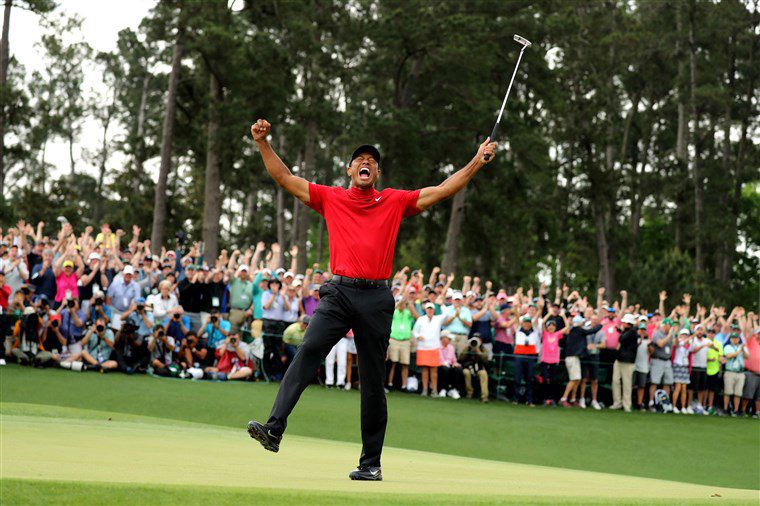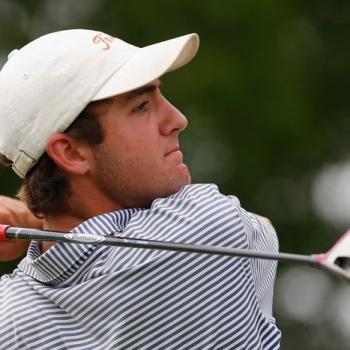 Forty-three year old Tiger Woods just made golfing history, winning the Masters by one stroke. He had won his first Masters in 1997 at 21 years of age. It was an amazing victory. He had gotten off to a really tough start even though he didn’t play poorly, shooting either a 39 or 40 the first nine. Yet for the rest of the tournament, he ran away from the field, winning by several strokes. Eleven years later, he won the last of his 14 major championships, in 2008, in the U.S. Open at Torrey Pines near San Diego. Today, it took him another eleven years to win one more, his 15th major.
Forty-three year old Tiger Woods just made golfing history, winning the Masters by one stroke. He had won his first Masters in 1997 at 21 years of age. It was an amazing victory. He had gotten off to a really tough start even though he didn’t play poorly, shooting either a 39 or 40 the first nine. Yet for the rest of the tournament, he ran away from the field, winning by several strokes. Eleven years later, he won the last of his 14 major championships, in 2008, in the U.S. Open at Torrey Pines near San Diego. Today, it took him another eleven years to win one more, his 15th major.
It also has to be one of the greatest comebacks in sports history among the great athletes. I don’t say athlete easy. I generally don’t categorize pro golfers as athletes; but in the case of Tiger Woods, definitely. He is an athlete.
For several years, golf fans and pros alike speculated on whether Tiger Woods could come back and win another major. Frankly, after all he had been through, I didn’t think he could do it. But his performance last year changed my mind. He had a chance to win two majors: the British Open and the PGA Championship, where he finished second. Then, he finally won again, this time late in the year at the limited-field Tour Championship. By then, I was a firm believer. I thought Tiger could win another major.
Tiger Woods also just made medical history. Coming back from four left knee surgeries and four lower back surgeries, with three vertebrae fused together, to win a Masters at age 43 is just amazing. I know from experience a little bit about injuries and surgeries and trying to play competitive pro golf. I had eight orthopedic surgeries during my pro golf career. Most of them were caused from golf. All four of Tiger’s surgeries were the result of the wear and tear that golf can produce on the body. Commentator and three-time Masters champ Nick Faldo said today that at the Masters Champions Dinner two years ago, when Tiger still was in pain and not able to compete on the PGA Tour, “Tiger said he feared he would never play golf again.” Just amazing.
Tiger finished one stroke ahead of Xander Shauffele, Brooks Keopka, and Dustin Johnson, who all finished tied for second. Tiger was playing in the last group. He had said going into the weekend that his main goal was to “stay patient.” During his career, he had gotten very excited when he pulled off some heroics, often giving a big uppercut to air as if he’s in a boxing match. He did the opposite of that today, remaining cool, what I would call Hoganesque.
When Tiger came to the 8th tee today, Nick Faldo said the next four tee shots were going to be so pivotal for Tiger. That would be the teeshots on the 8th, 9th, 10th, and 11th holes. Nick was so right. When you’re under pressure playing big time golf like that, the tendency is to be overly anxious to see where the ball goes when you hit it. Thus, the old advice that we’ve all heard since we picked up a stick never applies more than when you’re trying to win a golf tournament—keep your head down. The tendency is to lift the head too early in the forward swing and thus straighten the spine more than normal. The result is to hit the ball to the right of your target, sometimes way right. It seems to happen more with the long stick, the driver, than with the irons.
Well, Tiger hit three out of those four tee shots to the right, missing the fairway each time. Sometimes it’s better to be lucky than good. Tiger got lucky twice. He still had a clear shot on the 8th and 11th holes for his second shot. He was blocked by trees on the 10th, had to chip out, and got bogey. But he played those four holes in even par total.
Augusta National is such a strategic golf course, especially the back nine. It is such a mental exercise. On the back nine, starting on the 12th hole, Tiger played exactly the right way on every shot to the greens. His experience on this golf course and under Masters pressure taught him that, and it paid off.
There are four especially dangerous shots at Augusta National, and the Masters just makes them all that more perilous. They are the second shot on the par four 11th, the tee shot on the short par three 12th, the second shot on the par five 13th, and the second shot on the par five 15th. You must contend with water on each of those shots. Plus, every year on Sunday, Masters officials place the pin on the 12th green on the far right. That then becomes the most dangerous shot the entire week in the Masters.
And today’s weather conditions made that shot on the 12th hole even more menacing. The wind was blowing somewhat and increasing its speed as play progressed. Officials had set the tee times at least four hours earlier due to expected foul weather this afternoon. Wind plays havoc with golfers on the 12th hole at Augusta National. You may not hardly feel it standing on the tee because of elevated trees right behind the tee for quite a stretch. Then it is the same behind the green. Yet, between the tee and green, it is like a valley that criss-crosses the fairway. The green is elongated sideways and extremely narrow from front to back. And Rae’s Creek runs right in front of the green. You can hit what you think is the prettiest shot with your 8 or 9 iron, which you think is going to be close to the hole, only to see your hopes dashed when the wind catches the ball and it falls out of the sky onto the steep bank fronting the green. When that happens, the ball almost always rolls backward into the water.
The last four players out of five today hit their tee shots on the 12th hole pretty much at the pin. Nick Faldo said the balls landed nearly 30 feet short of their target. All balls landed on the bank fronting the green and rolled into the water.
Most damaging was Molinari’s shot that did so. He had been leading the tournament all the way to that point throughout the day, with Tiger chasing close behind. But Tiger, who was paired with Molinari and played next, aimed 30 feet to the left of the pin, right over the little sand bunker fronting the middle of the green. His ball went right there, to the middle of the green. He played it the Nicklaus Way. Jack Nicklaus had always said that with the pin on the far right, as it always is only on Sunday, you should aim at the middle of the green and thus not be tempted to go at the pin.
Tiger had a two stroke lead at 14 under par as he stepped to the 18th tee. Brooks Koepka was on the 18th green then with a fairly easy birdie putt of about 12 feet. If he made that putt, that would have put him finished at 13 under par, one behind Tiger. But Brooks missed left without touching the cup. It was difficult to tell if he pulled the putt or not. In the interview afterwards, he said he thought he hit the putt where he needed to hit it, but the ball didn’t roll accurately.
Tiger hit his three metalwood barely in the right edge of the fairway. He had to slice his second shot somewhat. I thought it was difficult to tell if his ball hit overhanging tree limbs or not. It ended about fifty yards short right of the green. I thought he was going for the green. Tiger then pitched to about 15 feet short of the hole with an easy two putt. His first putt missed lightly right, leaving him about a one foot putt for the one stroke win. As it turned out, if Koepka had made his birdie putt on that last, they would have tied and had a playoff.
Nothing could be better for pro golf than Tiger Woods winning the Masters today. Congratulations Tiger! (I did meet the Tiger one day, many years ago.)
[I played the Masters six times. I made the 36-hole cut three times. My best finish was 15th. I was inexperienced playing the fast greens at Augusta National. Growing up in the Pacific Northwest, and playing college golf in Houston and living thereafter there, I was used to slow greens. It took me several years on the PGA Tour before I felt comfortable on slick, fast greens.]














